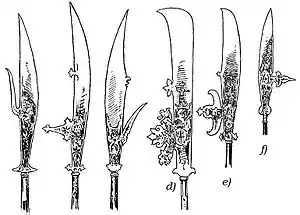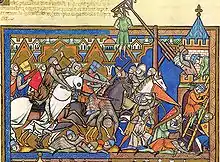Glaive
A glaive (or glave) is a European polearm, consisting of a single-edged blade on the end of a pole. It is similar to the war scythe, the Japanese naginata, the Chinese guandao, the Korean woldo, and the Russian sovnya.

Overview
Typically, the blade is around 45 cm (18 in) long, on the end of a pole 2 m (7 ft) long, and the blade is affixed in a socket-shaft configuration similar to an axe head, rather than having a tang like a sword or naginata. Occasionally, glaive blades were forged with a small hook on the reverse side to better catch riders. Such blades are called glaive-guisarmes.
According to the 1599 treatise Paradoxes of Defence by English gentleman George Silver, the glaive is used in the same general manner as the quarterstaff, half pike, bill, halberd, voulge, or partisan. Silver rated this class of polearms above all other individual hand-to-hand combat weapons.

The Maciejowski Bible (Morgan Bible) depicts an example of a two-handed glaive used on horseback.
The contemporary term for this weapon may have been faussart, which was used for a variety of single-edged weapons seen as related to the scythe (along with terms such as falchion, falcata, or fauchard derived from falx, the Latin term for "scythe").
It has been argued that the glaive had its origin in Wales, and that it remained a national weapon until the end of the XVth Century. Grose mentions a warrant (Harleian MS., No. 433) issued to Nicholas Spicer, dated the first year of Richard III's reign, 1483 for enrolling of smiths for "the making of two hundred Welsh glaives" – twenty shillings and sixpence being the charge for thirty glaives with their staves, made at Abergavenny and Llanllowel.[2]
Other uses of the word
The word "glaive" has historically been given to several very different types of weapons; it originated from French. Almost all etymologists derive it from either the Latin (gladius) or Celtic (*cladivos, compare claymore) word for sword. Nevertheless, all the earliest attestations in both French and English refer to spears.[3] It is attested in this meaning in English roughly from the 14th to 16th centuries.[4]
Around the same time, it also began being used as a poetic word for sword.[5] In Modern French, glaive refers to short swords, especially the Roman gladius.
The term "glaive" is used in the science-fiction/fantasy film Krull to refer to a thrown weapon, similar to the shuriken, chakram, or mambele, which can return to the thrower, much like a boomerang. Glaive has been used to describe this fictional type of weapon in films, video games (such as Dark Sector), and other fantasy media since.[6][7]
References
- Wendelin Boeheim (1890), "Die Glese und die Couse, figure 396", Handbuch der Waffenkunde. Das Waffenwesen in seiner historischen Entwicklung vom Beginn des Mittelalters bis zum Ende des 18. Jahrhunderts [Handbook of Weapon Knowledge. Weaponry in Its Historical Development from the Beginning of the Middle Ages to the End of the 18th Century.], Seemanns kunstgewerbliche Handbücher, VII, Leipzig: E. A. Seemann, pp. 343–344, OCLC 457086621
- Laking, Guy Francis (1920). A Record of European Armour and Arms Through Seven Centuries. Vol. III. London: G. Bell and Sons. p. 104.
- OED s.v. Glaive: "Hatz.-Darm. regard OF. glaive as an adapted form of L. gladius (through the stages gladie, glaie, glavie). Ascoli supposes it to represent a Celtic *cladivo- (OIr. claideb sword, Gael. claidheamh). Neither view, however, accounts for the earliest meaning of the word in OF., which is also that of MHG. glavîe, glævîn, MDu. glavie, glaye, Sw. glaven."
- OED s.v., section 1, lists examples in this meaning from 1297–1592.
- OED s.v., section 3, lists examples in this meaning from c. 1470–1887.
- "Why is a large shuriken sometimes called a "glaive"?".
- "Warcraft III - Night Elves -> Units - Glaive Thrower".